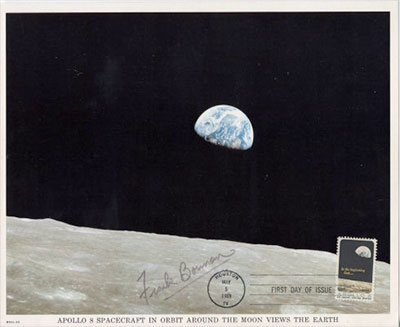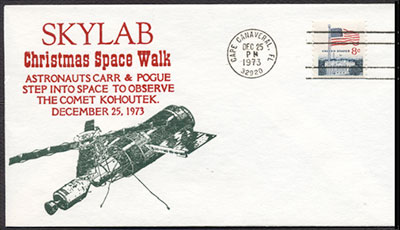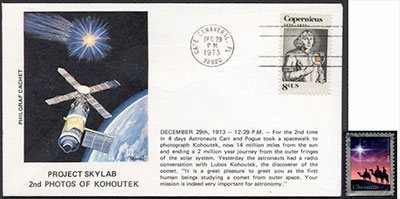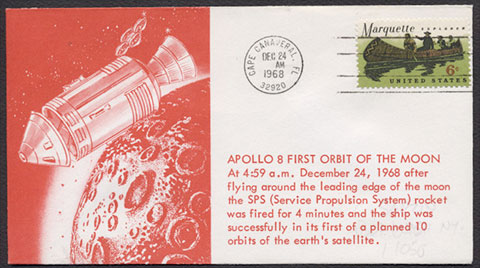Space Cover 349: Christmas in SpaceHow would you like to spend Christmas in space? Here are two instances of men who have done just that.
December 24th 1968.
The Soviet Union was going all out to beat the U.S. in sending men to the moon. However, their N1 moon rocket blew up on each of the four occasions when they tried to launch it. The second explosion destroyed their entire launch pad area.
But the U.S. was still concerned that they might be able to beat us there and moved the Apollo 8 moon shot up to launch on December 21, 1968. With six million parts on the Saturn 5 rocket there was always a good chance that something could go wrong and it was believed, and later justified, that redundant systems in potential problem areas could reduce the risk substantially.
This first manned launch to the moon has almost been forgotten due to the success of landing two men on the moon with the July 24, 1969 Apollo 11 mission, but this Apollo 8 flight was a major breakthrough for NASA and the United States.
On Christmas eve, 1968 the crew of Frank Borman, Jim Lovell and Bill Anders fired retro rockets as they went around the backside of the moon. The NASA team at the Johnson Space Center in Houston, Texas held their collective breaths waiting for the transmission that would come when the capsule came out from behind the moon. Then it happened and a cheer went up that Christmas eve.
The world watched and listened as the Apollo 8 camera showed the world a black and white live video image of the lunar surface, seemingly sliding across their window. Commander Frank Borman, then spoke:
"In the beginning, when God created the heavens and the earth, the earth was a formless wasteland, and darkness covered the abyss, while a mighty wind swept over the waters." From that same opening page of the bible it reads, "God made the two great lights, the greater one to govern the day and the lesser one to govern the night, and he made the stars."

It was a space-sent Christmas message never to be forgotten and the first words, "In the beginning God..." appear overlaid on a United States postage stamp, showing an image of the first "Earthrise" ever seen by humans from God's vantage point." A first day of issue cancellation of this stamp appears on this lithograph of that scene.

But that was not the only Christmas spectacular from space. Fast forward five years to December 25, 1973. Three wise men followed a star across the heavens, using instruments this time in addition to their eyes. Additionally, these three men, Jerry Carr, Ed Gibson, and Bill Pogue were not on camels, but were aboard the Skylab 4 space station in Earth Orbit. On that Christmas day, while Pogue stayed in the station, Carr and Gibson took a walk in space to behold the image of this star. "The star which they had observed went ahead of them... "They were overjoyed at seeing the star." Those are two 2000 year old biblical quotes that apply to this, much later, event as well.

"But," many people might say, "that wasn't a star. It was a comet, discovered by Lubos Kohoutek and named after him."
That is true, but let's look at the word "comet" more closely. It comes from the Latin, "Cometes" which in turn came from the Greek "Kometas" meaning "Head with Long Hair" or "Long-haired star." And that perfectly describes a bright, starry head followed by a long trail of misty hair-like light that we've all seen if we have been lucky enough to witness a comet. Comets were first cited in history around 1,000 BC and were named by Greek natural philosophers around 500 BC. That theory held for about a century. Then Aristotle (382 to 322 BC) opined that comets are not stars at all but merely dry and warm exhalations from the Earth's lower atmosphere. Aristotle was a very powerful scientist, so his definition held ground until near the end of the 17th century.
Edmund Halley (1656-1742) set out to disprove Aristotle by demonstrating that comets indeed traveled like planets in closed orbits around the sun. He used various mathematical formulae, some concocted by Newton and some concocted by himself. And he showed that many, but certainly not all, of the comet sightings across human history represented a single astral phenomenon. There was one that was seen in 1682 and he predicted it would come back in 1758. And right on time, it appeared. That comet was later named after him. Perhaps you may have seen it a few years ago: Halley's Comet. It has since returned in 1834, 1910 and 1984. Our grandchildren or theirs, will see it again in 2062.
A comet did have a direct tie-in to Christmas. Just before the birth of Christ, a comet was seen flying over Judea. Soothsayers told Herod, the king of Israel, that this presaged the birth of a boy who would someday outshine the monarch. In response Herod ordered a mass killing of all the male children under two years of age in Bethlehem. We call this "the slaughter of the innocents."
Still, the word Kometas still has the meaning of "Long Haired Star." Thus these three men, aboard Skylab 4, wise in many ways and orbiting around the Earth, followed a star in the heavens on that Christmas Day.
















